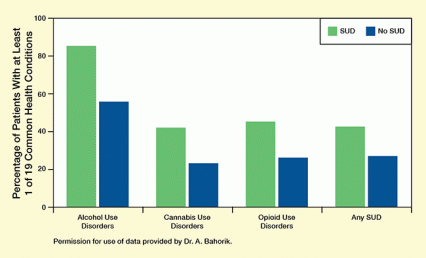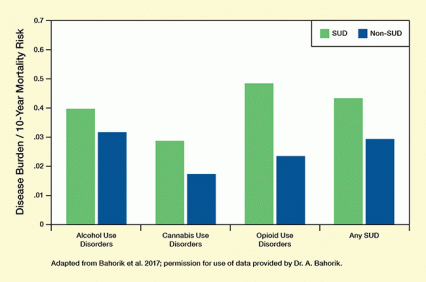This study:
- Showed strong associations between substance use disorder diagnoses and 19 major medical illnesses among patients in a large, integrated health care system.
- Indicates that these associations may persist even in health care systems that provide specialized treatment for substance use disorders and have capacity to integrate behavioral and medical care.
Dr. Amber Bahorik and colleagues at the University of California, San Francisco, in collaboration with colleagues at the Kaiser Permanente Division of Research, compared the medical records of all patients in the Kaiser Permanente Northern California health care system diagnosed with a substance use disorder (SUD) in 2010, to an equal number of patients without SUDs. Of the 45,461 patients who had SUDs, 57.6 percent met criteria for alcohol use disorder, 14.9 percent for cannabis use disorder, and 12.9 percent for opioid use disorder. Most (68.5 percent) had two or more SUDs.
 Figure 1. Patients With Substance Use Disorders (SUDs) Have an Increased Risk of Major Medical Conditions In a large, integrated health care system, the combined prevalence of 19 common health conditions was higher in patients with alcohol use disorders, cannabis use disorders, opioid use disorders, or any SUD than in demographically matched patients without SUDs. The 19 conditions were acid-peptic disorders, arthritis, asthma, chronic kidney disease, chronic obstructive pulmonary disease, chronic pain, congestive heart failure, coronary atherosclerosis, diabetes mellitus, end-stage renal disease, headaches, hepatitis C, hypertension, injury (including poisoning and overdose), ischemic heart disease, pneumonia, obesity, osteoporosis, and stroke.
Figure 1. Patients With Substance Use Disorders (SUDs) Have an Increased Risk of Major Medical Conditions In a large, integrated health care system, the combined prevalence of 19 common health conditions was higher in patients with alcohol use disorders, cannabis use disorders, opioid use disorders, or any SUD than in demographically matched patients without SUDs. The 19 conditions were acid-peptic disorders, arthritis, asthma, chronic kidney disease, chronic obstructive pulmonary disease, chronic pain, congestive heart failure, coronary atherosclerosis, diabetes mellitus, end-stage renal disease, headaches, hepatitis C, hypertension, injury (including poisoning and overdose), ischemic heart disease, pneumonia, obesity, osteoporosis, and stroke.
- Text Description of Figure 1
-
The bar chart shows the percentage of patients (from 0 percent to 100 percent) of patients with or without substance use disorders (SUDs) who also had at least 1 of 19 common health conditions. Values for patients with SUDs are shown in green, and values for demographically matched control subjects without SUDs are shown in blue. The left pair of bars represents people with and without alcohol use disorder. About 85 percent of patients with alcohol use disorder have any coexisting condition, compared with about 55 percent in the control group. The second pair of bars represents people with and without cannabis use disorder. About 42 percent of patients with cannabis use disorder have any coexisting condition, compared with 23 percent in the control group. The third pair of bars represents people with and without opioid use disorder. About 45 percent of patients with opioid use disorder have any coexisting condition, compared with about 26 percent in the control group. The right pair of bars represents people with or without any SUD. About 43 percent of patients with any SUD have any coexisting condition, compared with 27 percent of those without any SUD.
 Figure 2. Patients With Substance Use Disorders (SUDs) in a Large, Integrated Health Care System Have an Increased Disease Burden Disease burden was measured as 10-year mortality risk. Patients with any SUD or with alcohol, cannabis, or opioid use disorders had a greater 10-year mortality risk (i.e., a greater disease burden) than demographically matched patients without SUDs.
Figure 2. Patients With Substance Use Disorders (SUDs) in a Large, Integrated Health Care System Have an Increased Disease Burden Disease burden was measured as 10-year mortality risk. Patients with any SUD or with alcohol, cannabis, or opioid use disorders had a greater 10-year mortality risk (i.e., a greater disease burden) than demographically matched patients without SUDs.
- Text Description of Figure 2
-
The bar chart shows the difference in disease burden, as indicated by 10-year mortality risk, for people with and without substance use disorders (SUDs). Values for patients with SUDs are shown in green, those for demographically matched control subjects without SUDs are shown in blue. The vertical (y-) axis shows the 10-year mortality risk on a scale from 0.0 to 0.7. The left pair of bars represents patients with and without alcohol use disorders. The 10-year mortality risk for those with an alcohol use disorder is about 0.39, compared with approximately 0.31 for the control group. The second pair of bars represents patients with and without cannabis use disorders. The 10-year mortality risk for those with a cannabis use disorder is about 0.28, compared with approximately 0.18 for the control group. The third pair of bars represents patients with and without opioid use disorders. The 10-year mortality risk for those with an opioid use disorder is about 0.48, compared with approximately 0.23 for the control group. The right pair of bars represents patients with or without any SUD. The 10-year mortality risk for patients with any SUD is about 0.44, compared with approximately 0.29 for the control group. Asterisks above the bars for cannabis use disorders, opioid use disorders, and any SUD indicate a statistically significant difference between patients with and without SUDs (p < 0.001)
Consistent with what studies in other populations have found, the patients with SUDs had higher prevalence of 19 major health problems (see Figure 1 and Table). Chronic pain, chronic obstructive pulmonary disease, congestive heart failure, and hepatitis C were among the most elevated. The patients with SUDs also had heightened 10-year mortality risk, indicated by higher than average disease-burden scores (see Figure 2). Patients with opioid use disorders exhibited the highest elevation in 10-year mortality risk, with average disease-burden scores (M = 0.48; SE = 1.46) that were nearly twice as high as patients without (M = 0.23; SE = 0.09) opioid use disorder.
Dr. Bahorik’s study is the first to demonstrate in a largely privately insured, integrated health care system that SUDs and other medical conditions are common and are associated with a higher burden of chronic disease and associated 10-year mortality risk, particularly for patients with opioid use disorders. Dr. Bahorik says that the integrated health model offers opportunities for reducing the disease burden associated with SUDs, and to achieve this aim providers should implement strategies to enhance screening and treatment: “Primary care clinicians can identify substance use problems early and deliver evidence-based interventions to address the addiction process before the disorder becomes more chronic and complex,” she says. “This integrated approach is important to improve substance use as well as other health outcomes.” In support of this premise, she points to reports that medical conditions that are exacerbated by substance use tend to improve as substance use diminishes with treatment.
| Substance Use Disorder | Medical Condition |
|---|---|
| Alcohol use disorder | Cardiovascular diseases Cancers Injuries Stroke Cirrhosis |
| Opioid use disorder | Arthritis Chronic pain Headache Hepatitis C Musculoskeletal disorders Opioid-related overdoses |
| Cannabis use disorder | Respiratory deficits Cardiovascular diseases Lung cancer |
Although Dr. Bahorik’s study provides insight into the relationship between SUDs and other medical conditions in this large patient group, it has some limitations. The cross-sectional design did not allow the researchers to determine whether patients’ SUDs caused their other medical problems, whether their medical problems contributed to the development of the SUDs, or both. As a possible example of the disease-to-drug use progression, Dr. Bahorik cites observations that some patients become opioid dependent after being treated with prescription pain medications, which could help account for her study’s finding that opioid use disorder was associated with the greatest disease burden. “It is also possible that patients with major medical conditions use alcohol, opioids, or cannabis to reduce pain or stress, but we were not able to examine these questions with these data,” Dr. Bahorik explains. She concludes, “Our findings suggest that patients with SUDs are more likely to have multiple co-occurring conditions, which signals a need to examine these relationships to inform more effective screening and intervention practices.”
Dr. Bahorik adds, “Cost considerations reinforce the need to identify and treat substance use problems early,” because the high prevalence and associated disease burden of chronic conditions can result in higher health care costs over time, both for patients with SUDs and for the health care system.
This study was supported by NIH grant DA007250.
Source:
Bahorik, A.L., Satre, D.D., Kline-Simon, A.H., et al. Alcohol, cannabis, and opioid use disorders, and disease burden in an integrated health care system. Journal of Addiction Medicine 11(1):3-9, 2017.
